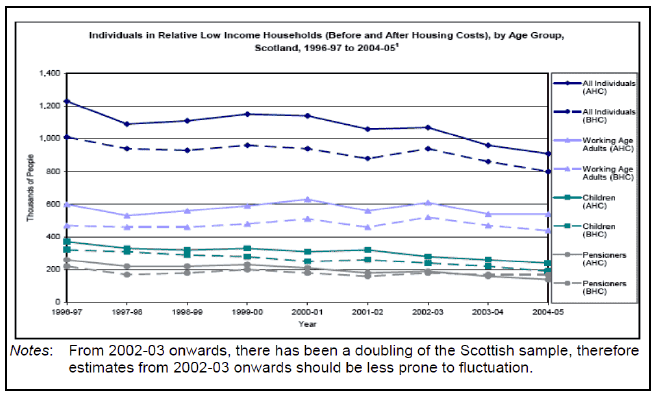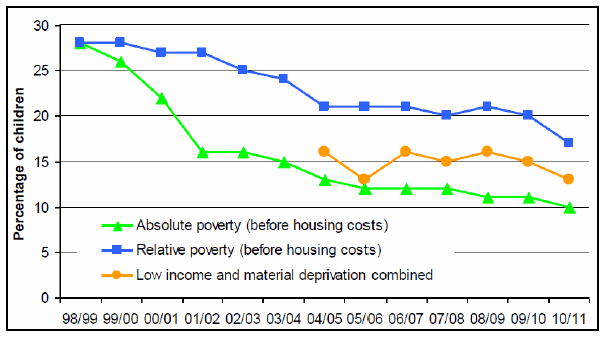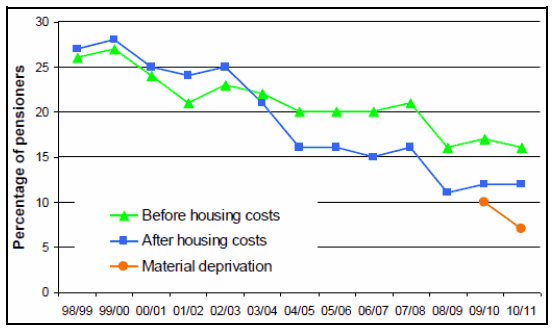Scottish Government Equality Outcomes: Age Evidence Review
This evidence review was prepared to support the production of the Scottish Government's Equality Outcomes, with regard to age.
5 Poverty
5.1 This section explores child poverty, working-age poverty, welfare reform, pensioner poverty, and in-work poverty.
5.2 The EHRC Review of Research[36] offers an overview of the trends in low income for all age groups (see Figure 7). The issue of low pay has been decreasing for all age groups, but most markedly for households with children and for pensioner households. Data from 2004/05 (before housing costs) shows that 19% of all children in Scotland were living in relative low income households, a reduction of 41% since 1996/97. The number of pensioners living in low-income households was 18% in 2004/05, having fallen from 23% since 1996/97. These figures compare with an average of 15% of working-age low-income households.
Figure 7: Relative low-income households by age, 1996/97-2004/05 (Source: EHRC Review of Research, 2009)

Child poverty
5.3 Between 1998/99 and 2004/05 the percentage of children in relative and absolute poverty[v] (before housing costs) in Scotland fell markedly. After 2004/05, the rates did not show much change up to 2009/10. Figures for the percentage of children in low income and material deprivation combined have only been available since 2004/05. They have not changed substantially and have remained around 15% or 16% until 2009/10 before dropping slightly in 2010/11[37].
5.4 Between 2009/10 and 2010/11, all three child poverty indicators reported a decrease in the child poverty rate (see Figure 8)[38]. The percentage of children in relative poverty (before housing costs) decreased from 20% to 17%, a reduction of 20,000 children to 170,000 children. The proportion of children in absolute poverty (before housing costs) decreased from 11% to 10%, a reduction of 10,000 children. The percentage of children in material deprivation and low income combined decreased from 15% to 13%, a reduction of 20,000 children.
Figure 8: Child Poverty in Scotland: 1998/99 - 2010/11 (Source: Poverty and Income Inequality in Scotland, 2012)

5.5 The risk of poverty is far greater for children in workless families than those in families where one or more adults is employed or self-employed (71% of children in workless families are poor compared to 11% of children in working families)[39]. The same publication found that child poverty is more concentrated in deprived areas than in the rest of the country. In 2008/09, 45% of children in the 15% most deprived areas were living in relative poverty (before housing costs).This figure compares to 17% in the rest of the country.
5.6 With regards to the distribution of relative poverty in families with children, the highest prevalence of poverty is for families with a youngest child aged 0-4 years: 24% of such families are in poverty[40]. Parents in this category will be youngest on average, and therefore are likely to earn less than older parents. Also, parents with a young child are more likely to work fewer hours. The rates of poverty are also high (21%) for families with a youngest child aged 16-19 years. This could be due to retired parents and costs for higher education. The rates are smaller for families with the youngest child aged 5-10 (16%) and 11-15 (18%).
5.7 Over the period 2005 to 2008, 13% of children in Scotland lived in persistent poverty (before housing costs)[41]. Persistent poverty rates for children fell across all the GB countries between 1999 to 2002 and 2005 to 2008.
5.8 According to Growing Up In Scotland[42], nearly one quarter of three- to four-year-old Scottish children are persistently poor, defined as living in income poverty in at least three of the four years from 2005/06 to 2008/09. Just over four in ten of children had experienced poverty in at least one of the years over the same period.
5.9 The same research has found that how long children experience poverty is linked to child outcomes. Persistently poor children are disproportionately likely to face social, emotional and behavioural difficulties, be overweight and have multiple problems.
5.10 Having parents who are regularly without work is the factor with most bearing on persistent poverty: around 140,000 children in Scotland live in workless households, and two-thirds of them are in lone parent households[43]. Living in social rented housing, living in deprived areas, being the member of a large family or a lone-parent family and having a mother with low or no qualifications are all associated with persistent poverty.
5.11 Regarding welfare reform, the Children's Society[44] observes that the household benefit cap will disproportionately affect families with children. It uses the Department for Work and Pensions' impact assessment of the number of households likely to be affected to conclude that, in Great Britain, an estimated 210,000 children will be affected compared to 70,000 adults.
Working-age poverty
5.12 Poverty and Income Inequality in Scotland: 2010-11[45] shows that since around 2003/04, working age poverty has remained fairly stable and has not shown the same extent of early decreases observed in child and pensioner poverty. In 2010/11 the proportion of working age adults in relative poverty (before housing costs) dropped from 16% to 14%. This represents a reduction of 70,000 individuals, to 440,000. The proportion of working age adults in relative poverty (after housing costs) dropped from 20% to 18% between 2009/10 and 2010/11 (a reduction of 40,000 individuals). The proportion in absolute poverty (before housing costs) remained unchanged at 10 %, while the (after housing costs) figure dropped from 14% to 13% between 2009/10 and 2010/11.
5.13 The drop in child poverty in Scotland over the last decade has naturally been accompanied by a fall in poverty among working-age adults living with dependent children[46]. But this fall has been accompanied by a steady rise in poverty among working-age adults without dependent children, both in and out of work.
5.14 As for the factors that have influenced the reduction in relative poverty in 2010/11, Poverty and Income Inequality in Scotland: 2010-11[47] lists the following:
- Median equivalised household income decreased in real terms (down from £439 to £416 in 2010/11), which in turn decreased the relative poverty thresholds.
- Individual earnings fell in real terms in 2010/11 and this was one of the main factors in the reduction in median incomes.
- Benefit and tax credit income grew in cash terms and fell only slightly in real terms. This meant that low-income benefit-dependent households saw their income fall less in 2010/11 than households at the median, tending to decrease the overall rate of relative poverty, before and after housing costs.
5.15 Persistent poverty rates for working age adults are lower than for children and pensioners. Between 1999 to 2002 and 2005 to 2008 these rates were relatively flat in England and Scotland[48].
5.16 Regarding welfare reform, the Department for Work and Pensions (DWP) has published an Equalities Impact Assessment for Universal Credit[49]. It models the positive impact of Universal Credit on the distribution of participation tax rate (calculated as the proportion of earnings which are lost in tax, national insurance or reduced benefit payments when a person moves into work) for people moving into ten hours of work per week at the minimum wage, and shows that the improvement is seen across all age groups. In summary, DWP concludes that households of all ages will see significant improvements in their incentives to work.
5.17 Currently Working Tax Credit is not available to those under 25 unless they have children or are disabled, so younger people should benefit particularly from the reduced taper and integration of in and out-of-work support. This should help to promote employment incentives and opportunities for younger people.
5.18 In contrast, the Joseph Rowntree Foundation[50] observes that worsening unemployment figures, specifically the rise in people working part-time instead of full-time, indicate that the issue is the lack of jobs, not an unwillingness to look for work. Joseph Rowntree Foundation conclude that policies that focus solely on changing incentives to find work via benefit reform cannot solve this problem.
5.19 The Department for Work and Pensions' impact assessment of the new Benefits Cap[51] anticipates that around 80% of those affected by the cap will be aged 25 to 44, as those under 25 tend to receive less benefit, and are less likely to have children. Most of the other 20% affected will therefore be 45 or over. The cap will only apply to working-age benefits and will not impact on single people or couples who have both reached the qualifying age for Pension Credit. In Housing Benefit the cap will not apply to most couples where one partner has reached the qualifying age for Pension Credit.
Pensioner poverty
5.20 The fall in pensioner poverty since 1998/99 has been steeper than comparable falls for children and working age adults. The latest data on poverty and income inequality on Scotland[52] shows that 160 thousand pensioners were living in relative poverty in 2010/11. Pensioner relative poverty before housing costs decreased slightly from 17% in 2009/10 to 16% in 2010/11 (see Figure 9), whilst the pensioner relative poverty measure after housing costs remained at 12% in 2010/11. (Pensioners are the group where outright ownership is common hence after housing costs poverty is lower than before housing costs). 7% of over 65s were materially deprived in 2010/11, this is a decrease from 10% in 2009/10.
Figure 9: Pensioner Relative poverty: 1998/99 - 2010/11 (Source: Poverty and Income Inequality in Scotland, 2012)

5.21 The explanation given by the same report is that households containing pensioners at the lower end of the income distribution generally received a larger proportion of their income from benefits and a smaller proportion from other sources. So because benefit income grew more than earned income, households with pensioners saw their overall income fall less in real terms in 2010/11 than other households with more income from earnings.
5.22 Dividing up pensioners into 5-year age bands, the poverty rate is fairly stable for the age categories below 80 years (between 13% and 16%). However, for the 80-85 years age group this rises to 18%, and for 85 years and over the rate is 22%[53].
5.23 In Scotland persistent poverty among pensioners (after housing costs) fell from 17% to 5% between 1999 to 2002 and 2005 to 2008[54]. This was the largest drop seen in any GB country for this group.
In-work poverty
5.24 8% of children and 8% of working age adults live in in-work poverty households[55]. On average, children are slightly more likely than working age adults to be in households where no-one is working.
Income inequalities by age group
5.25 53% of pensioners and 47% of children are in the bottom two income quintiles (the bottom 40%), compared to 34% of working age adults[56]. 55% of households with a youngest child aged 0-4 years are in the bottom two income quintiles. This compares with 41% of households with a youngest child aged 5 or over[57].
Coping financially
5.26 There are marked age-related differences in how people are managing financially, with an increase in those managing well as people get older (36% of those aged 16-24 up to 61% of those aged 75 plus), as against a decreasing pattern for those not managing well (21% of those aged 16-24 down to 2% of those aged 75 plus)[58]. In almost every case, as the age of the household head increases, so too do the savings of the family. 64% of families headed by a 16-24 year-old have no savings. Families that are most likely to have savings are those with a household head over 75 (74%). Families with a household head aged 60-74 were most likely to have savings over £20,000 (19%). The least likely were families headed by a 16-24 year old (the likelihood is so small that it rounds to 0%).
Contact
Email: Social Research
There is a problem
Thanks for your feedback